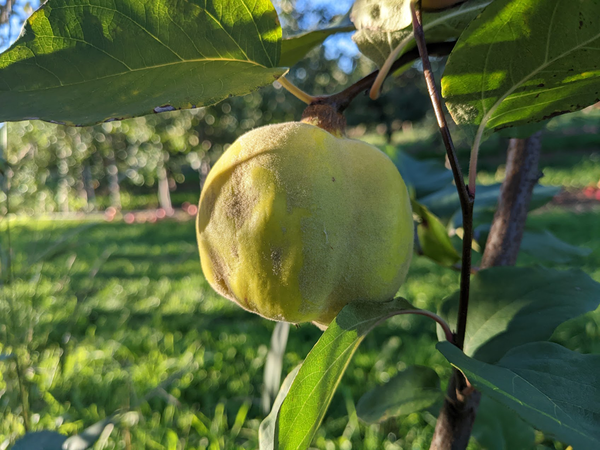An attractive, highly disease-resistant apple, ideal for organic growers.
Orange Quince Quince on Quince Provence (Spring 2024)
A large, fragrant quince. Also known as Apple.
Quince (Cydonia oblonga) trees are self-fertile, but will be more productive with a pollen partner. In spring, toward the end of apple bloom, the tree will produce showy, white or pink blooms on new growth. Like other pome fruits it should be lightly pruned in winter when fully dormant, and it is usually trained into a vase or open-centered tree as its growth habit does not lend itself to a strong central leader. Quince is susceptible to fireblight. Although pear trees can be grafted onto quince rootstocks, the reverse is not true, and quince will not thrive on a pear rootstock.
"Orange" (AKA "Apple") refers to a group of quinces rather than a specific genotype. Its origin is uncertain, but the group is distinguished by being orange (or apple) shaped. The tree is vigorous, hardy, and productive. It is susceptible to fungal infections. This quince grows very well in the northeast, as it ripens best in cool weather. The fruit is very large and round, varying from orange-yellow to greenish-yellow, and covered in a thick fuzz. The flesh is orange-yellow, tender, and aromatic.
Although quince is no longer a popular fruit in contemporary America, it was revered in Ancient Greece and Middle East as the fruit of love and happiness, and it may have been the infamous "apple" of the Garden of Eden (The biblical name for quince translates as "golden apple".) In colonial America, the fruit was a valuable source of pectin and flavoring for jams, jellies, and candies.
The Fruit
Fruit Type
Fruit Uses & Storage
Uses: cider, jam, baking, storage, canning, freezing, jelly, sauce
Storage duration: three plus months (approximate, depending on storage conditions)
Fruit Appearance
Skin color: yellow
Flesh color: off-white
Fruit Origins
Parentage:
Origin:
Introduced in:
Introduced by:
The Environment
Calendar & Geography
USDA zones: 4 - 9
Chill hours: Not yet determined
Ripening date: (approximate, in New York State) days after
Tree Height & Spacing
glossary
Rootstock: Quince Provence Rootstock
Rootstock size class: Half-Standard (55% of Standard)
Tree spacing: See details
Good for wildlife planting? N
Diseases & Pests
glossary
Fireblight: Susceptible
Pollination
Pollination Factors
glossary
Bloom group:
Is it self-fertile? Y
Is it fertile? Y
Rootstock size class:
Half-Standard (55% of Standard)
Pollination Partners
This table shows the first few results from a full search for pollenizers of Orange Quince Quince on Quince Provence. Please see our Pollenizer Search to run other queries and read how the application uses various factors. Also read more about fruit tree pollination.
See all pollination matches for Orange Quince Quince on Quince Provence
Featured Products
A few things we're loving right now...
A full-flavored, freestone white peach.
One of America's oldest apples, good for storage, baking, and cider.
A widely-grown, large, yellow-fleshed nectarine.
















